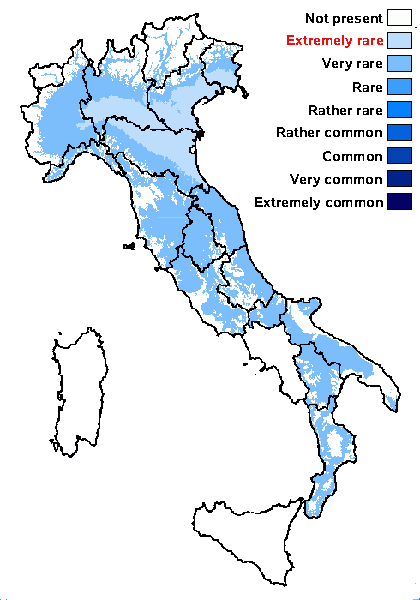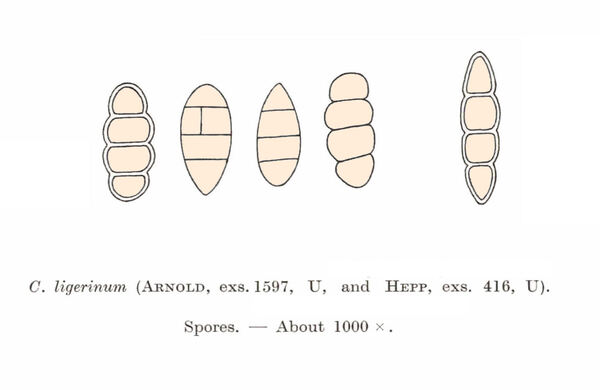Enchylium ligerinum (Hy) Otálora, P.M. Jørg. & Wedin
Fungal Divers., 64, 1: 286, 2013. Basionym: Collema pulposum var. ligerinum Hy - Mèm. Soc. Nat. Agricult. Sc. Arts Angers: 24, 1893.
Synonyms: Collema ligerinum (Hy) Harm.; Collema verruculosum auct. p.p.; Lathagrium conglomeratum sensu A. Massal.; Leptogium verruculosum (A. Massal.) Jatta
Distribution: N - VG, Frl (Castello & Skert 2005), Ven, TAA (Nascimbene & al. 2007b), Lomb (Brusoni & al. 1997, Brusoni & Valcuvia 2000), Piem (Piervittori 2003, Isocrono & al. 2004), VA (Piervittori & Isocrono 1999), Emil (Fariselli & al. 2020), Lig (Giordani & al. 2009, Giordani & Incerti 2008). C - Tosc, Marc (Nimis & Tretiach 1999, Frati & al. 2004, Frati & Brunialti 2006, Brackel 2015), Umb (Ravera 1998, Ravera & al. 2006, Brackel 2015), Laz, Abr (Recchia & al. 1993, Olivieri & al. 1997, 1997b, Loppi & al. 1999, Gheza & al. 2021), Mol (Caporale & al. 2008). S - Pugl, Bas (Nimis & Tretiach 1999, Ravera & al. 2021c), Cal (Puntillo 1996, Puntillo & Puntillo 2004, Incerti & Nimis 2006).
Description: Thallus small-foliose to subsquamulose, homoiomerous, gelatinous and 150-550 µm thick when wet, forming 5-10(-16) mm wide cushions. Lobes few, 0.5-1.5(-2) mm wide, flattened, adpressed to erect, usually branched, distinctly swollen, sometimes with adventive lobules. Upper surface dark olive-green to brown or black, dull, epruinose, without isidia; lower surface usually paler bluish grey, with scattered white hapters. Upper and lower cortices absent. Apothecia common, lecanorine, numerous and crowded on lobe margins or terminal and often hiding the lobes, sessile and constricted at base, 0.5-1(-2) mm across, with a concave to flat, dark reddish brown disc and a rather thick, but finally often excluded, entire, smooth thalline margin. Thalline exciple ecorticate; proper exciple euthyplectenchymatous; epithecium brownish; hymenium colourless, 85-105 µm high, I+ blue; paraphyses simple or sparingly branched, 2-3 µm thick at mid-level, the apical cells clavate, up to 4.5 µm wide; hypothecium yellowish. Asci 8-spored, cylindrical-clavate, the apex strongly thickened, the apical dome K/I+ pale blue, with a downwardly projecting K/I+ deep blue tubular structure. Ascospores 3-septate, hyaline, oblong or ovoid with usually rounded ends, sometimes slightly constricted at septa, (14.5-)17-24 x 6-8.5 µm. Pycnidia common, mostly marginal, immersed, globose, paler than thallus. Conidia bacilliform, slightly swollen at both ends, 4.5-5 x c. 1 µm. Photobiont cyanobacterial (Nostoc, the cells in long chains). Spot tests: all negative. Chemistry: without lichen substances.Note: a mild-temperate species found on base-rich bark, especially of Juglans and Populus; more widespread in the past, but locally still common near small settlements in montane valleys, e.g. in the eastern Pre-Alps. It is included in the Italian red list of epiphytic lichens as “Near-threatened” (Nascimbene & al. 2013c).
Growth form: Foliose, narrow lobed
Substrata: bark
Photobiont: cyanobacteria, filamentous (e.g. Nostoc, Scytonema)
Reproductive strategy: mainly sexual
Commonnes-rarity: (info)
Alpine belt: absent
Subalpine belt: absent
Oromediterranean belt: absent
Montane belt: absent
Submediterranean belt: very rare
Padanian area: extremely rare
Humid submediterranean belt: very rare
Humid mediterranean belt: absent
Dry mediterranean belt: absent

Predictive model
Herbarium samples
Growth form: Foliose, narrow lobed
Substrata: bark
Photobiont: cyanobacteria, filamentous (e.g. Nostoc, Scytonema)
Reproductive strategy: mainly sexual
Commonnes-rarity: (info)
Alpine belt: absent
Subalpine belt: absent
Oromediterranean belt: absent
Montane belt: absent
Submediterranean belt: very rare
Padanian area: extremely rare
Humid submediterranean belt: very rare
Humid mediterranean belt: absent
Dry mediterranean belt: absent

Predictive model
| Herbarium samples |
 INDEX FUNGORUM
INDEX FUNGORUM
 GBIF
GBIF
 DOLICHENS
DOLICHENS




